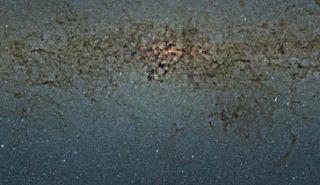
An ESO photo.
WASHINGTON (PTI): Astronomers have created a catalogue of 84 million stars at the heart of the Milky Way using an enormous cosmic photo snapped by a telescope in Chile.
The view is billed as the largest survey ever of the stars in our galaxy's core.
The staggering 9-gigapixel picture was created with data gathered by the Visible and Infrared Survey Telescope for Astronomy (VISTA).
The zoomable image is so large that it would measure 30 feet long by 23 feet tall if printed with the resolution of a typical book, researchers said.
The catalogue derived from the new image contains 10 times more stars than previous studies have provided. It should help astronomers better understand the structure and evolution of our home galaxy, researchers said in a statement.
"By observing in detail the myriads of stars surrounding the centre of the Milky Way we can learn a lot more about the formation and evolution of not only our galaxy, but also spiral galaxies in general," study lead author Roberto Saito.
The huge new picture probes the Milky Way's central bulge, a concentration of ancient stars found near the core of most spiral galaxies.
"Observations of the bulge of the Milky Way are very hard because it is obscured by dust. To peer into the heart of the galaxy, we need to observe in infrared light, which is less affected by the dust," said co-author Dante Minniti.
VISTA was able to do just that, snapping thousands of infrared images that were combined to generate a monumental colour mosaic measuring 108,200 by 81,500 pixels. It's one of the biggest astronomical images ever produced, researchers said.
Astronomers identified 173 million different objects in the 9-billion-pixel image, of which 84 million could be confirmed as stars. The rest were distant objects such as galaxies, or they were too faint or blended to be identified conclusively.
Saito and his team then plotted the brightness of each star against its colour, creating a colour-magnitude diagram with 84 million data points. These diagrams are valuable tools, helping astronomers study star properties such as temperature, mass and age.
"Each star occupies a particular spot in this diagram at any moment during its lifetime," Minniti said.
"Where it falls depends on how bright it is and how hot it is. Since the new data gives us a snapshot of all the stars in one go, we can now make a census of all the stars in this part of the Milky Way," he said.
 Previous Article
Previous Article Next Article
Next Article














The Indian Air Force, in its flight trials evaluation report submitted before the Defence Ministry l..
view articleAn insight into the Medium Multi-Role Combat Aircraft competition...
view articleSky enthusiasts can now spot the International Space Station (ISS) commanded by Indian-American astr..
view article